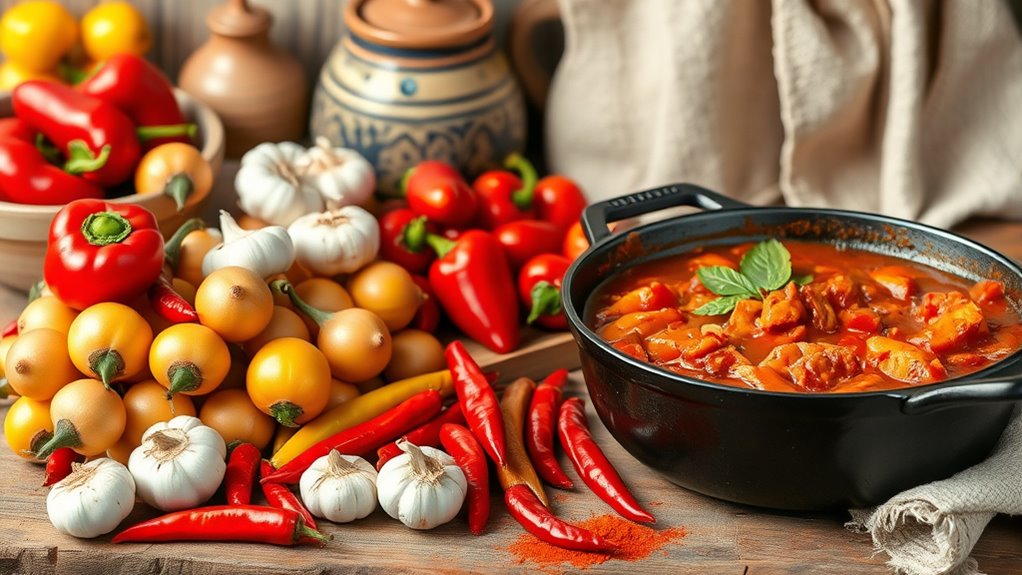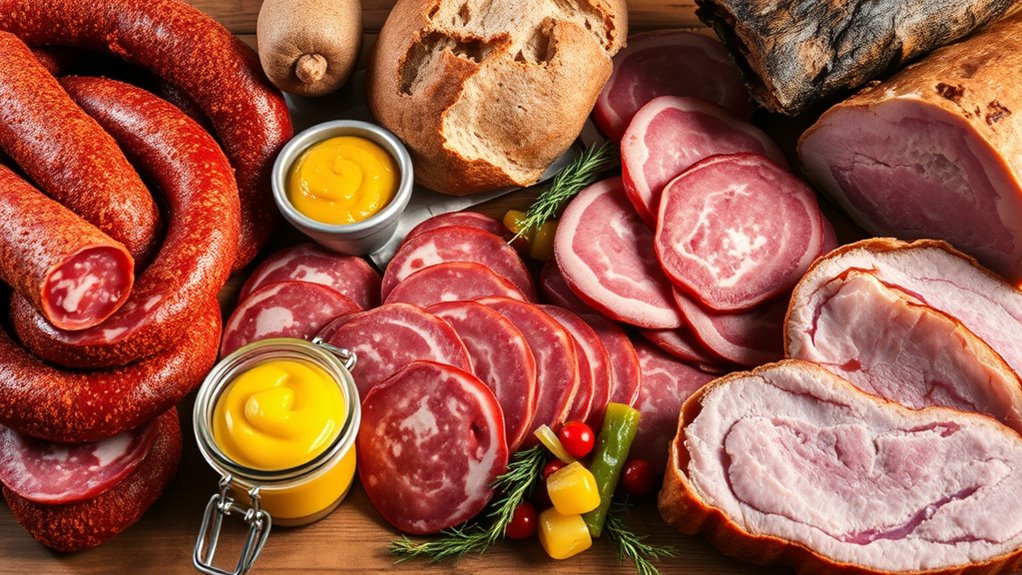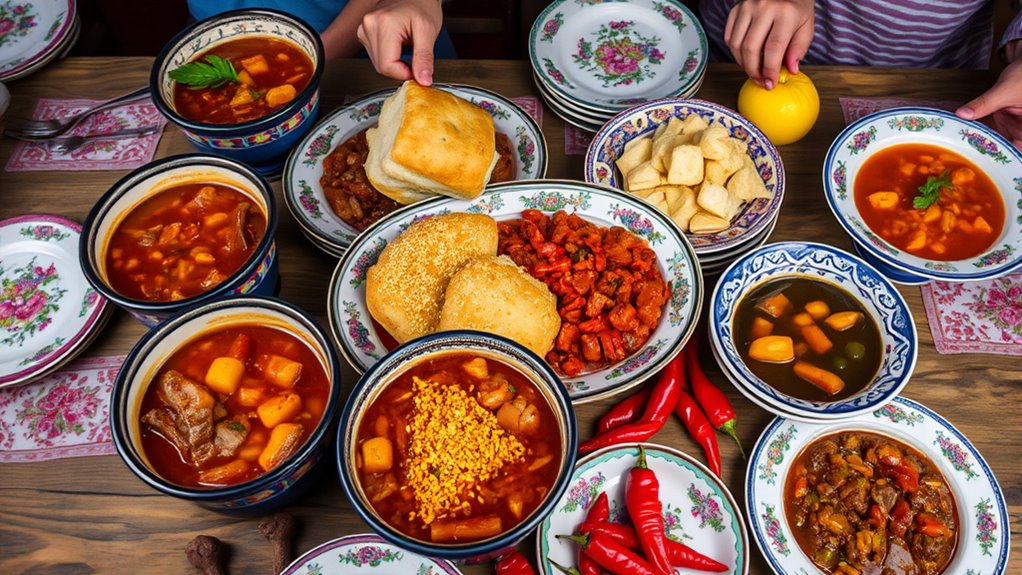Hungarian cuisine is famous for its bold flavors, especially its use of paprika, hearty meats like pork, and rich dairy products like sour cream. You’ll find traditional dishes like goulash, chicken paprikash, and fresh seasonal vegetables, often accompanied by homemade bread and pastries. Preservation methods like curing and smoking are key to their charcuterie. Exploring these authentic flavors and customs offers a taste of Hungary’s rich culinary heritage—there’s much more to discover below.
Key Takeaways
- Hungarian cuisine is renowned for its bold use of paprika, pork, and hearty spices in traditional dishes like goulash and chicken paprikash.
- Meals follow a structured pattern with substantial lunch, lighter dinner, and social dining customs emphasizing family and community.
- Charcuterie practices include curing, smoking, and seasoning pork sausages, reflecting a rich heritage of preservation techniques.
- Bread, pastries, and dairy products like sour cream play a central role in daily meals and festive celebrations.
- Seasonal vegetables and fruit soups highlight Hungary’s emphasis on fresh, local ingredients and culinary craftsmanship.
Key Ingredients and Spices in Hungarian Cooking

Hungarian cuisine is renowned for its bold flavors, which largely stem from its key ingredients and signature spices. You’ll find paprika, the star spice, available in sweet, mild, and hot varieties, giving dishes vibrant color and distinctive taste. Pork and lard form the foundation of many recipes, especially in sausages and stews, with Mangalica pork prized for its marbling and flavor. Garlic, onions, marjoram, caraway seeds, and dill seeds are common accompaniments, enhancing the depth of each dish. Seasonal vegetables like carrots, beets, tomatoes, and bell peppers add freshness and texture. Dairy products, especially sour cream and curd cheese, lend richness and tanginess. Together, these ingredients create the rich, smoky, and hearty flavors characteristic of Hungarian cuisine.
Classic Hungarian Dishes and Their Flavors

Many of Hungary’s most beloved dishes showcase a masterful use of paprika and hearty ingredients to create bold, memorable flavors. You’ll find that dishes like goulash, chicken paprikash, and fisherman’s soup highlight the vibrant red spice and its smoky, sweet, or hot varieties. These dishes rely on slow simmering to develop rich, layered tastes. To deepen your understanding, consider these key elements:
Hungarian dishes feature paprika, hearty ingredients, and slow simmering for bold, layered flavors.
- The use of pork and sausages, like Gyulai or Csabai, adding smoky, spiced notes
- The inclusion of seasonal vegetables, enriching stews and main courses
- The incorporation of dairy products, like sour cream, to balance flavors and add creaminess
Together, these components create the robust, comforting flavors that define Hungarian cuisine.
Traditional Meat and Charcuterie Practices

Hungarian meat and charcuterie practices highlight a rich tradition of curing and spicing pork sausages like kolbász, with regional varieties such as Gyulai and Csabai sausages. These techniques often involve smoking and seasoned preservation methods that date back generations. Cold meat platters featuring cured meats and pickles remain popular as both starters and celebratory dishes. Additionally, traditional methods emphasize genetic variation to achieve unique coat colors and flavors in their cured products.
Pork Sausages and Varieties
Have you ever tasted the rich, smoky flavors of Hungarian pork sausages? If not, you’re missing out on a true culinary treasure. Hungarian sausages like kolbász come in regional varieties such as Gyulai and Csabai, each with unique spice blends. These sausages are often smoked and heavily seasoned with paprika, garlic, and marjoram, giving them vibrant color and bold flavor. You’ll find them in traditional dishes or enjoyed on their own. Hungarian pork sausages are also used in hearty stews and served cold on platters alongside pickles. The preparation involves curing, smoking, and spicing—techniques passed down through generations. Their robust taste and smoky aroma embody Hungary’s meat and charcuterie heritage, making them a staple in Hungarian cuisine. Modern processing methods, such as smoking and curing techniques, help preserve the sausages’ flavor and extend shelf life.
Traditional Curing Techniques
Hungarian traditional curing techniques have been honed over centuries to preserve meat and develop characteristic flavors. You’ll find methods like smoking, salting, and drying, which enhance taste and guarantee longevity. These practices rely on natural methods, often using paprika and spices to add flavor and prevent spoilage. Cured meats, such as salami and sausages, are integral to Hungarian cuisine, especially during winter. Many of these techniques are preserved through traditional meat practices that continue to define Hungary’s culinary heritage.
| Technique | Meat Types | Key Flavors |
|---|---|---|
| Smoking | Pork, Mangalica | Smoky, spicy, rich |
| Salting | Sausages, salami | Salty, seasoned |
| Drying | Cured meats | Concentrated flavor |
These techniques create robust, flavorful products that reflect Hungary’s culinary history, shaping traditional charcuterie enjoyed today.
Popular Cold Meat Platters
Cold meat platters are a staple at Hungarian gatherings, showcasing a variety of cured and smoked meats that highlight the country’s rich charcuterie traditions. You’ll find an assortment of salamis, sausages, and cured meats, often served with pickles, fresh bread, and mustard. These platters emphasize Hungary’s mastery of preserving meats through smoking and curing techniques. You might encounter:
- Spicy Gyulai and Csabai sausages, known for their paprika flavor
- Winter salami, a slow-smoked, cured delicacy
- Mangalica pork meats, prized for marbling and rich flavor
These meats reflect Hungary’s regional styles and historical practices, offering a flavorful glimpse into the country’s culinary heritage. Cold meat platters are perfect for sharing, celebrating Hungary’s tradition of preserving and enjoying its favorite cuts. Preservation techniques play a key role in maintaining the flavors and textures of these traditional meats.
The Role of Bread and Pastries in Daily Life

Why does bread hold such a central place in Hungarian daily life? It’s because bread is more than just food; it’s a symbol of hospitality and tradition. You’ll find bread at nearly every meal—served alongside soups, stews, or as a simple accompaniment to cheese and cold cuts. Hungarians also enjoy pastries, both sweet and savory, for breakfast or as snacks. Freshly baked buns, strudels, and filled pastries reflect local flavors and seasonal ingredients. During festive occasions, special bread and sweet pastries are part of the celebration. Baking traditions, influenced by neighboring Central European cuisines, emphasize craftsmanship and variety. Whether plain or elaborately filled, bread and pastries provide daily sustenance, comfort, and a connection to Hungary’s rich culinary heritage. Incorporating traditional baking techniques ensures the authenticity and quality of these cherished foods.
Dairy Products, Soups, and Seasonal Delights

Dairy plays an essential role in Hungarian cuisine, enriching a variety of dishes with tangy and creamy flavors. You’ll find sour cream (tejföl) added to soups, stews, and sauces to enhance richness. Fresh curd cheese (túró) is used in both savory and sweet recipes, from filling for pastries to breakfast spreads. Seasonal delights like fruit soups highlight Hungary’s fresh produce, especially in summer. You might enjoy:
- Hearty gulyás and chicken paprikash, finished with a dollop of tejföl
- Invigorating fruit soups made with strawberries, cherries, or apricots
- Traditional hearty soups that combine vegetables, meats, and paprika for bold flavors
These ingredients and dishes reflect Hungary’s love for comfort, freshness, and seasonal bounty. Seasonal variations in ingredients and dishes also enhance the authentic culinary experience.
Cultural Aspects and Meal Structures in Hungary

You’ll notice that Hungarians typically follow specific meal time patterns, with lunch being the main daily event. Multi-course dining rituals emphasize savoring each dish, from soups to desserts, reflecting their cultural importance. Food holds deep significance, often bringing families and communities together to celebrate tradition and shared heritage. Additionally, traditional dishes like goulash showcase the rich culinary heritage of Hungary and are enjoyed during special occasions.
Traditional Meal Time Patterns
In Hungary, meal times follow a traditional pattern that emphasizes structure and social connection, with lunch serving as the main and most substantial meal of the day. You typically start your day with a light breakfast, often bread with butter, cheese, or jam. Midday, you enjoy a hearty lunch, which might include goulash, stuffed peppers, or vegetable stews, often accompanied by bread and sour cream. In the evening, dinner is lighter—such as cold cuts, salads, or a small soup. To deepen your understanding:
- Lunch is a social event, often shared with family or friends.
- Afternoon snacks or coffee breaks are common.
- Dinner usually occurs late, around 7-8 pm, reflecting Hungary’s leisurely meal rhythm.
Multi-Course Dining Rituals
Hungarian dining customs typically revolve around multi-course meals that emphasize harmony, tradition, and social interaction. When you sit down to eat, you’ll often start with a light soup, such as gulyás or fish soup, to warm the palate. Next comes the main course, usually a hearty meat dish like chicken paprikash, accompanied by bread or dumplings. Vegetables and dairy products may feature in side dishes or sauces. After the main, dessert—often a sweet pastry or fruit compote—is served to complete the meal. Throughout, meals are leisurely, allowing conversation and connection to flourish. Sharing these courses reflects Hungary’s appreciation for balance, heritage, and community, making dining an occasion that celebrates both food and togetherness.
Cultural Significance of Food
Food holds a central place in Hungary’s cultural identity, serving as a means of expressing tradition, hospitality, and community. You’ll find that meals are more than just sustenance—they’re social events that reinforce bonds. Hungarians value sharing hearty dishes like goulash or stuffed peppers, especially during family gatherings or festivals. The structure of meals reflects respect for tradition, often following a three-course pattern: soup, main, and dessert. You might notice these customs:
- Emphasis on communal dining to foster connection
- Use of signature ingredients like paprika to celebrate heritage
- Hospitality shown through generous portions and welcoming gestures
- Traditional serving practices often highlight the importance of presentation and etiquette during meals
Food acts as a cultural bridge, linking generations and regions, and showcasing Hungary’s rich history and regional pride.
Frequently Asked Questions
What Are the Regional Variations in Hungarian Paprika?
You’ll find regional variations in Hungarian paprika that influence flavor, color, and intensity. In Szeged, the paprika is often milder and sweeter, used for its vibrant red color and delicate aroma. Meanwhile, in Kalocsa, the paprika tends to be more pungent and hot, favored for adding depth and spice to dishes. These regional differences let you choose the perfect paprika to match your preferred taste and culinary style.
How Is Mangalica Pork Traditionally Prepared and Served?
Ever wondered how Mangalica pork shines in Hungarian cuisine? You’ll find it prepared simply to preserve its rich flavor—often roasted, smoked, or slow-cooked into hearty sausages like Csabai or Gyulai. It’s served sliced on cold meat platters, incorporated into stews, or enjoyed as crispy cracklings. Do you appreciate the unique marbling and tenderness that make Mangalica pork a prized delicacy? Its preparation highlights Hungary’s love for flavorful, traditional meats.
What Are the Most Popular Hungarian Desserts and Pastries?
You’ll find the most popular Hungarian desserts and pastries are Kürtőskalács, a chimney cake baked over open flames, and Dobos Torte, a layered chocolate sponge with caramel topping. You might also enjoy somlói galuska, a rich sponge soaked in rum and topped with whipped cream and chocolate. These treats showcase Hungary’s love for sweet, indulgent flavors, often featuring nuts, fruits, and caramel, perfect for satisfying your sweet tooth.
How Do Hungarian Breakfast Customs Differ Across Regions?
You’ll find breakfast customs vary across Hungary’s regions. In the east, people often start with hearty bread, fresh cheese, and cold cuts, while in the west, you might enjoy sweet pastries or fruit preserves with coffee. In rural areas, a simple, filling meal with bread, butter, and local cheeses is common, whereas urban centers embrace more diverse options like yogurt, eggs, and modern café-style offerings.
What Are Modern Influences Shaping Hungary’s Culinary Scene Today?
Hungary’s culinary scene is like a vibrant tapestry, woven with modern influences that add new colors and textures. You’ll find international cuisines blending seamlessly with traditional flavors, thanks to global travel, fusion restaurants, and social media. Chefs experiment with plant-based dishes, craft artisanal products, and incorporate health-conscious ingredients. This dynamic evolution keeps Hungarian cuisine alive and exciting, inviting you to explore familiar tastes reimagined in creative, contemporary ways.
Conclusion
As you explore Hungary’s rich culinary tapestry, you’ll find it’s like a vibrant quilt woven with bold spices, hearty meats, and golden pastries. Each dish tells a story, bursting with flavors that dance like lively folk tunes. Embrace the warmth of traditional bread and the comforting embrace of dairy and soups. Hungarian cuisine invites you to taste its soul—a delicious journey through a land where every bite is a colorful brushstroke on a flavorful canvas.








